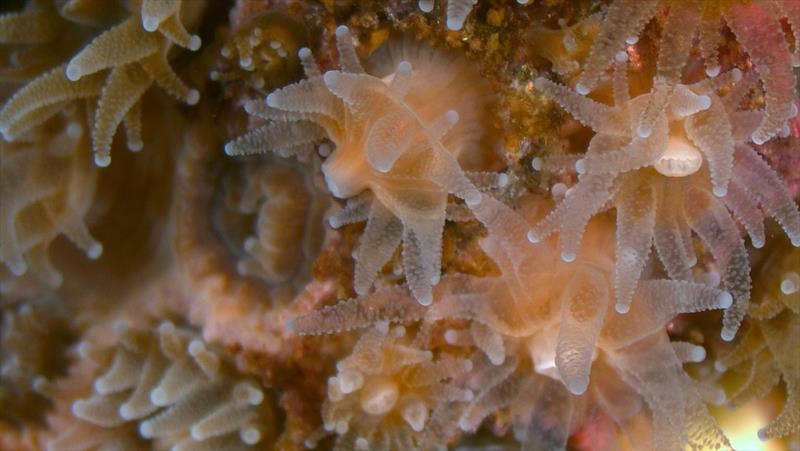
Northern Star Coral study could help protect tropical corals
by The Woods Hole Oceanographic Institution 15 Apr 2021 16:02 UTC

Close-up of a Northern Star Coral (Astrangia poculata) colony taken from a microscope in the laboratory at Roger Williams University, Rhode Island © Alicia Schickle
As the Rhode Island legislature considers designating the Northern Star Coral an official state emblem, researchers are finding that studying this local creature's recovery from a laboratory-induced stressor could help better understand how to protect endangered tropical corals.
A new study published today in mSystems, a journal of the American Society for Microbiology, investigates antibiotic-induced disturbance of the coral (Astrangia poculata) and shows that antibiotic exposure significantly altered the composition of the coral's mucus bacterial microbiome, but that all the treated corals recovered in two weeks in ambient seawater.
The stony Northern Star Coral naturally occurs off the coast of Rhode Island and other New England states in brown colonies with high (symbiotic) densities and in white colonies with low (aposymbiotic) densities of a symbiotic dinoflagellate alga. The study found that those corals with algal symbionts - organisms that are embedded within the coral's tissue and are required by tropical corals to survive - recovered their mucus microbiomes more consistently and more quickly.
The study also identified six bacterial taxa that played a prominent role in reassembling the coral back to its healthy microbiome. This is the first microbiome manipulation study on this coral.
"The work is important because it suggests that this coral may be able to recover its mucus microbiome following disturbance, it identifies specific microbes that may be important to assembly, and it demonstrates that algal symbionts may play a previously undocumented role in the microbial recovery and resilience to environmental change," the paper states.
With thermal bleaching and disease posing major threats to tropical corals, this research, along with other work on tropical corals, "provides a major step toward identifying the microbiome's roles in maintaining coral resilience," the paper notes.
"We think that the algae are helping the coral select the microbes that live with it, and this suggestion of symbiont-microbe coordination following disturbance is a new concept for corals," said paper co-author Amy Apprill, associate scientist at the Woods Hole Oceanographic Institution.
"Worldwide, coral reefs are in crisis. Any time we see corals recover, that's always good news. It shows that they can combat a stressor and figure out how to become healthy again," said Apprill. "What we found here is translatable to tropical corals which are faced with different stressors, such as warming water, disease, and pollution. This paper suggests that the symbiotic algae play a major role in providing consistency and resilience to the coral microbiome."
"When we think about corals, it's usually assumed that we're thinking about the tropics and the bright blue water and where it's warm, sunny, and sandy. However, the Northern Star Coral lives in murkier and much colder waters, yet it can still teach us a lot about expanding our understanding of corals," said lead author Shavonna Bent, a student in the MIT-WHOI Joint Program in Oceanography/Applied Ocean Science and Engineering.
The Northern Star Coral is an ideal emblem for Rhode Island, said co-author Koty Sharp. The coral is small like the state; it's New England-tough in dealing with large temperature fluctuations; and it's a local, offering plenty of insight that can help address global problems, said paper co-author Koty Sharp, an associate professor at Roger Williams University who is leading the effort for official designation of the coral.
Committees from both the Rhode Island House and Senate have held hearings on the proposed legislation. The Senate has approved the bill, and the House could vote on it in the coming month. Assuming the House also approves the bill, it will be sent to Rhode Island Gov. Daniel McKee for signing into law.
Sharp said the designation effort has a big educational component. "If designating this as a state emblem allows us to teach more people about the power of basic research to support conservation, or if this allows us to teach a generation of school children about the local animals that live around them, then this state coral will have a great deal of value," she said.